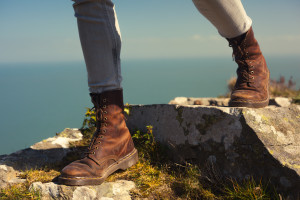
How can we establish a habit of fitness for our children and ourselves?
May I recommend a step at a time?
Hugh Gailey from Stevenson, Washington walked 100 miles per week at ninety-four years young. Mr. Gailey said, “shoe leather is cheaper than medicine and doctor’s bills. Walking is the best exercise for any age.”
Childhood obesity grows epidemic as our children spend more time inside with TV, computers, video games and more. Many of our neighborhoods lack good sidewalks or walking paths, and as parents, we are fearful of letting our children out alone to walk to school, to visit friends, or to attend after school activities.
Setting aside time regularly to walk with your children will help establish a lifelong fitness habit. It might put some pep in your step, too.
Establish a family walking time. Plan for three walks per week that last for 30 minutes to an hour. Put it on the calendar so that it becomes part of your family’s routine.
Enter walking events. Many organizations offer walk/run events with families in mind. Sign up with friends and neighbors and have a walking party.
Get a dog (or borrow a friend’s). Dogs need to be walked at least once a day. The larger the dog, the longer and more frequent the walks need to be. If you need help keeping on a fitness track, a dog may help. Also, a dog offers some protection.
Get pedometers. Children find it a blast to see how many steps they’ve taken in a day. Seeing the number of steps can serve as an incentive to do a little more, and perhaps promote some friendly competition.
Take nature walks. Use guidebooks for flowers, trees, clouds and birds to identify discoveries on your journeys. The Audubon Society has pocket sized books and guide sheets.
Bring a healthy snack. Stop and have an apple or a handful trail mix. A little surprise treat can help make walking seem special. Depending on the length of your walks, and local climate, consider bringing water with you, too.
Change it up. Walk in different areas instead of the same four blocks in your neighborhood. Local and state parks have trails that can take you out to nature.
Take a map. Use your walks to teach map reading. Let your children plan your route. Walks can help your children learn north, south, east and west. Street, traffic and directional signs take on new meaning for your children as you walk with a map.
Walk and talk. Use your walks to visit, catch-up, discuss family values or tell family stories. Scheduled walks allow your children to know they will have the time to bring up certain subjects that they might otherwise not address.
Be safe. Wear reflective gear (reflective tape works well on the back of jackets) or walking lights if out at dusk or dark. Walk against traffic when walking in the street. Use sidewalks and crosswalks properly. Look seventeen times before crossing the street.
As you establish family walk times, you might find that you’re out rain or shine. So, get out your calendar. Dig out those walking shoes. Open your front door and you’re on your way.

Dear Maren,
This is a fabulous idea! I will certainly include it in our family’s routine. But first I need to buy comfortable walking shoes. I just realize my girls have only sandals and shoes but not leather ones…
I’ll get back to you in one month to tell you how it is going.
Thanks!!!!
Emanuella,
The shoes don’t have to be leather. That’s more a figure of speech.
But comfortable walking shoes are important.
I love to walk and this is one of the requirements for every pair of shoes I buy: Can I walk five miles in these shoes?
Have fun! And let me know how it goes!